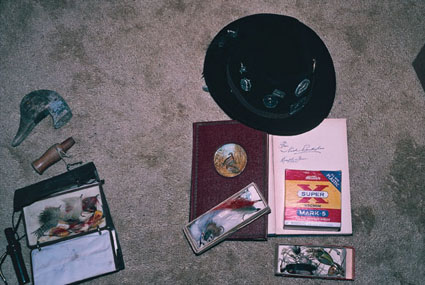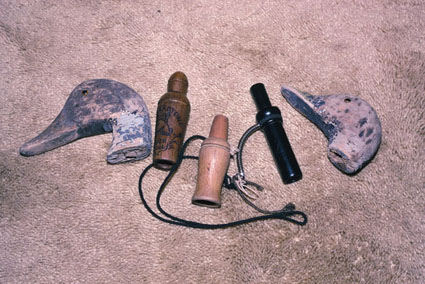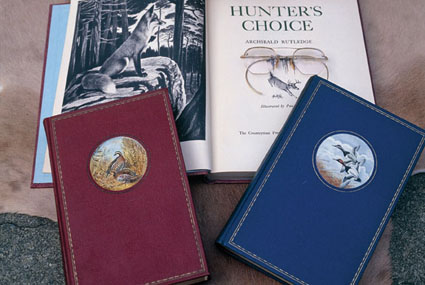 One of the most prevalent and widespread of human tendencies, particularly as we age, is to harken back to the “good old days.” In many cases, even in sport, those times in yesteryear were actually far less appealing than the current situation. Take, for example, the sagas of the American wild turkey or the white-tailed deer. As a boy growing up in the 1950s, I had no opportunity to hunt either species — they were scarce to non-existent in the North Carolina high country where I was raised. Today they are, as my Grandpa Joe used to say about something that was ordinary or plentiful, “common as pig tracks.”
One of the most prevalent and widespread of human tendencies, particularly as we age, is to harken back to the “good old days.” In many cases, even in sport, those times in yesteryear were actually far less appealing than the current situation. Take, for example, the sagas of the American wild turkey or the white-tailed deer. As a boy growing up in the 1950s, I had no opportunity to hunt either species — they were scarce to non-existent in the North Carolina high country where I was raised. Today they are, as my Grandpa Joe used to say about something that was ordinary or plentiful, “common as pig tracks.”
On the other hand, when it comes to waterfowl, with the notable exceptions of domestic Canadas and snow geese, calling back yesteryear truly does take us to the “good old days.” As the title of an interesting and entertaining book on the subject by Ed Muderlak puts it, that was a time “When Ducks Were Plenty.” What follows is a short journey, through the medium of armchair adventure, down darkening avenues into a delightful world we have largely lost. Our guides are some of the great chroniclers of waterfowling’s glory days — men who knew the magic of untold thousands of whistling wings at dawn and the joy of vast bevies of ducks silhouetted against the rosy dusk of a December day as they flew to roost.
Nash Buckingham
Take, for example, one of the finest outdoor writers America has produced, the legendary Nash Buckingham. “Mr. Buck,” as he was widely known, spent almost his entire life in the American heartland of the Mississippi Flyway, and to read his tales of duck hunting at his beloved Beaver Dam Hunt Club is to know vicarious waterfowling at its best. To his credit, Buckingham was one of the first to realize the problems being wrought by overshooting, market hunting, habitat destruction, overly liberal seasons and limits, and the like. He acknowledged his own culpability in a story entitled “The Prodigal Years,” and he deserves credit for being one of the staunch proponents of strict limits and sound conservation.
Mr. Buck was a prolific writer, producing hundreds of magazine pieces over the course of his long career. While some of these are now available only through the pages of forgotten, dust-laden magazines, many of them formed the basis for his books. These include “De Shootinest Gent’man,” “Mark Right,” “Tattered Coat,” “Game Bag,” “Old Miss,” “Blood Lines” and “Hallowed Years.” All have been reprinted multiple times and remain comparatively easy to find (inexpensively) on the out-of-print market. Buckingham knew how to weave a tale with rare verve, and to read of his great double-barrel Bert Becker magnum, “Bo Whoop;” to hear the exploits of his faithful boat poler and sidekick, Ho’ace; or to join him for the first flights of mallards on a blustery winter day in stories with memorable titles such as “Recall to Eden,” “Opportunity Flies but Once,” or “Great Day in the Morning” is vicarious sport at its best.
Archibald Rutledge
 A contemporary of Buckingham’s was perhaps the most prolific sporting scribe of the 20th century, Archibald Rutledge. “Old Flintlock,” as Rutledge’s family styled him, wrote about a whole host of hunting subjects and is probably best remembered for his stories of deer and turkey. Yet his waterfowling stories, which take us back to a simple time when paddling ’em up or even walking creeks for jump-shooting were commonplace, are written in a warm and winsome way which reminds us that the sport can be one of simplicity instead of elaborate blinds and ornate decoy spreads. Rutledge’s stories are scattered through scores of books, almost all of them now quite scarce, but you can get something of the measure of the man in one of several anthologies I have done on him, “Hunting and Home in the Southern Heartland.”
A contemporary of Buckingham’s was perhaps the most prolific sporting scribe of the 20th century, Archibald Rutledge. “Old Flintlock,” as Rutledge’s family styled him, wrote about a whole host of hunting subjects and is probably best remembered for his stories of deer and turkey. Yet his waterfowling stories, which take us back to a simple time when paddling ’em up or even walking creeks for jump-shooting were commonplace, are written in a warm and winsome way which reminds us that the sport can be one of simplicity instead of elaborate blinds and ornate decoy spreads. Rutledge’s stories are scattered through scores of books, almost all of them now quite scarce, but you can get something of the measure of the man in one of several anthologies I have done on him, “Hunting and Home in the Southern Heartland.”
Gordon MacQuarrie
When it comes to flat-out entertainment mixed with a solid undercurrent of information, perhaps no one rivals the waterfowling writings of Gordon MacQuarrie. This staunch son of the upper Midwest is often acclaimed as America’s first full-time outdoor writer for a newspaper (the Milwaukee Journal). That may or may not be the case, but certainly the articles he wrote on waterfowling for the major national magazines of his day place him well to the forefront of our revered waterfowling writers. Most of these were anthologized in a trilogy compiled and edited by Zack Taylor and published under the titles “Stories of the Old Duck Hunters,” “More Stories of the Old Duck Hunters” and “Last Stories of the Old Duck Hunters.” Taylor was also the editor of another anthology, this one not limited to waterfowl but including several duck-hunting stories, “MacQuarrie Miscellany.” Also of note for any serious MacQuarrie fan (and if you haven’t read his stuff, you have a treat awaiting you) is Keith Crowley’s biography, “Gordon MacQuarrie: The Story of an Old Duck Hunter.”
Van Campen Heilner
If one were to select the single most influential book on American waterfowling, Van Campen Heilner’s “A Book on Duck Shooting” would certainly be a leading candidate. In fact, its only serious competition would be George Bird Grinnell’s “American Duck Shooting,” a book which Heilner’s work largely superseded. Although he wrote several books on saltwater angling, this was his only volume on waterfowling. Heilner loved the solitude of the duck blind, the sweet sounds of ducks flying by before dawn brought light to the sky, and the biting winds and slate horizons of a howling nor’easter. When he writes of miscellaneous waterfowling memories, he says his mind “goes back to endless wind-swept Autumn days, to the howl of wind and the beat of rain, to ice locked estuaries, to geese flighting in to the fields at dawning, to the whisper of wings over some pond at sunset, to a thousand and one days and nights in near lands and far.” Yet Heilner evokes more than sights and sounds. From a more practical standpoint, you will search in vain for a finer general primer carrying you from Alberta’s grain fields to Mexico’s salt marshes and embracing all the vast waterfowling paradise in between. Then too, there’s the added bonus of wonderful art work by the incomparable Lynn Bogue Hunt and dozens of photographs.
Eugene Connett And Colleagues
If Van Campen Heilner’s book stands in a class by itself, Eugene Connett must be reckoned the single most important figure in the literature of waterfowling when one looks at him as an author, editor and publisher. As the scion of the famed Derrydale Press, he published books by great waterfowling writers such as Buckingham, Roland Clark, Joel Barber, Lynn Bogue Hunt, Horatio Bigelow, and others. He was also a prolific author in his own right, but for present purposes it was his editing and compiling of two massive anthologies, “Wildfowling in the Mississippi Flyway” and “Ducks Along the Atlantic Tidewater.” The contributors to these two books read like a who’s-who of writers at the time the two books were published (in the late 1940s). You won’t find the same memorable and moving passages provided by some of the others mentioned here, but for a general picture of duck and goose hunting as they were in the middle of the 20th century, you can do no better.
 One of Connett’s stable of authors who published under the Derrydale Press imprint was Roland Clark. He is today best remembered as a great wildlife artist, but he was also splendid when it came to capturing the ethos of waterfowling’s appeal. His books, “Stray Shots” and “Gunner’s Dawn,” are rightly recognized as classics, and when he writes of his “thoughts moving with the wind” or “feeling the icy spray as it drives across my sinkbox,” you feel as if you are at Clark’s side.
One of Connett’s stable of authors who published under the Derrydale Press imprint was Roland Clark. He is today best remembered as a great wildlife artist, but he was also splendid when it came to capturing the ethos of waterfowling’s appeal. His books, “Stray Shots” and “Gunner’s Dawn,” are rightly recognized as classics, and when he writes of his “thoughts moving with the wind” or “feeling the icy spray as it drives across my sinkbox,” you feel as if you are at Clark’s side.
Robert Ruark
The waterfowl-related stories of the individual I personally consider the greatest of all American outdoor writers, Robert Ruark, shouldn’t be overlooked. The scope of Ruark’s coverage in his enduring tales of a wonderful youth spent on the North Carolina Coast, “The Old Man and the Boy” and “The Old Man’s Boy Grows Older,” range widely, but as is the case with Buckingham, his duck- and goose-hunting experiences stand well to the forefront.
In his story “You Got to be Crazy to be a Duck Hunter” (and who would disagree?), Ruark goes right to the heart of matters when he describes freezing feet, ears on fire with cold, and half-frozen droplets hanging from his nose, then says “I was never happier in my life.” He then quotes the Old Man (his maternal grandfather) on their status at the moment: “Just look at the pair of us. Froze stiff, probably going to die of pneumonia, wet, muddy and miserable, and both of us grinning at each other like Chessy cats. We’re crazy as loons, but then you got to be a little crazy to be a duck hunter.”
Or consider his description of going goose hunting by himself, carrying a pair of double-barrels, and knocking four honkers from the heavens. “I couldn’t begin to describe the emotions. When you’ve got four dead Canada geese on the ground at once, you don’t know which one to pick up first. I ran from one to the other like a nervous old lady. The guns, I thought, had a new dignity, because I had never met anybody who had killed four Canada geese in one salvo. It was as if I had shot four elephants.”
There are other writers of note — lots of them. William Bruette, Herbert Gardner, William Barber Haynes, Albert Hochbaum, Ray Holland, Kip Farrington and Bert Claflin, among others, come to mind. So when you’ve gathered decoys in the darkness of the season’s last day, when roseate hues have turned to black and another annual cycle of waterfowling is at an end, turn to these pages for some armchair adventure and join some grand old gunners for a literary reminder that those truly were the days.






